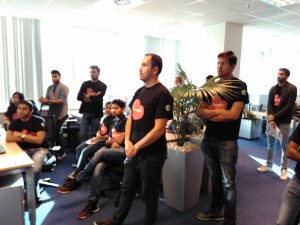 IPIS was one of the NGO’s participating in the first Belgian DataMinds Analytic-A-Thon in the weekend of 22 October. The Analytic-A-Thon is a new event format organised by Cognizant, an international consulting firm, that brings together its employees and local NGO’s. About 25 young and bright consultants, equipped with specialised tools for data visualisation (including Tableau and Qlik) dedicated their weekend to assist the participating NGO’s to answer outstanding questions on how to use their own (or publicly available) data.
IPIS was one of the NGO’s participating in the first Belgian DataMinds Analytic-A-Thon in the weekend of 22 October. The Analytic-A-Thon is a new event format organised by Cognizant, an international consulting firm, that brings together its employees and local NGO’s. About 25 young and bright consultants, equipped with specialised tools for data visualisation (including Tableau and Qlik) dedicated their weekend to assist the participating NGO’s to answer outstanding questions on how to use their own (or publicly available) data.
The NGO’s first presented their work and focus, the available data and some of their open research questions. Then, it was up to Cognizant employees to form small teams, pick one NGO and explore its data. Together with the NGO’s representative, they formulated one or more challenging yet feasible research questions to focus on over the course of the weekend.
IPIS presented data collected during its 2013 – 2015 artisanal mining campaigns in eastern DRC. This dataset contains entries for every mine visited by IPIS. The data have been collected, processed, checked, prepared for internal statistical analysis and analysed by IPIS over the course of the last years. The analysis, as well as much of the data itself, was recently published by IPIS in an interactive webmap and accompanying report. Nevertheless, due to the many many variables available in this database, the various relations between them and the ever growing number of analysis techniques, it was clear that this data contains some unexploited opportunities.
Two t eams of six presented themselves to focus on the IPIS artisanal mining dataset. One team focussed on identifying remarkable entries, such as mines with extremely high or low production rates compared to the amount of miners. Findings either represent suspicious values that could be checked with the ground teams who visited the mines, or indicate remarkable sites for future research. A second team set out to display the datasets’ information from the perspective of the final destination of the mining exports (typically larger towns in DRC). Given that multiple minerals can be produced in the same mine, each with possibly different final destinations, this can be a challenging task. The outcome of the analysis presented at the end of the workshop is very valuable: from an international supplier’s point of view it is interesting to know, e.g. the overall amount of armed presence at the mines shipping to each of the larger towns. Finally, in a more adventurous take, one participant also applied some preliminary Machine Learning techniques on the dataset in order to discover correlations between the different features.
eams of six presented themselves to focus on the IPIS artisanal mining dataset. One team focussed on identifying remarkable entries, such as mines with extremely high or low production rates compared to the amount of miners. Findings either represent suspicious values that could be checked with the ground teams who visited the mines, or indicate remarkable sites for future research. A second team set out to display the datasets’ information from the perspective of the final destination of the mining exports (typically larger towns in DRC). Given that multiple minerals can be produced in the same mine, each with possibly different final destinations, this can be a challenging task. The outcome of the analysis presented at the end of the workshop is very valuable: from an international supplier’s point of view it is interesting to know, e.g. the overall amount of armed presence at the mines shipping to each of the larger towns. Finally, in a more adventurous take, one participant also applied some preliminary Machine Learning techniques on the dataset in order to discover correlations between the different features.
The teams worked intensely throughout the weekend and presented their findings to the NGO’s on Sunday evening. The results were very useful to IPIS, both in terms of feasibility of new approaches and in terms of actual insights. They will be an inspiration as IPIS continues to investigate its data and expand its analysis techniques – as it has been doing over the last years.

